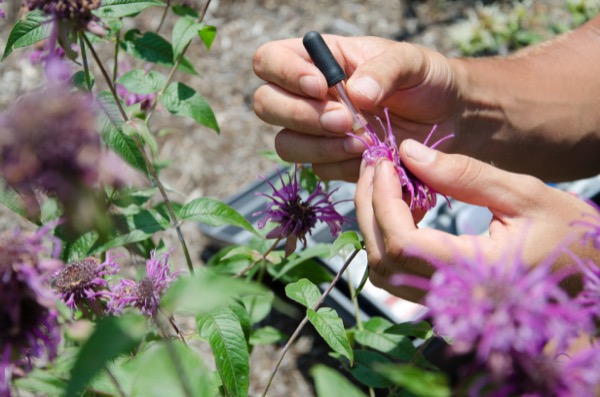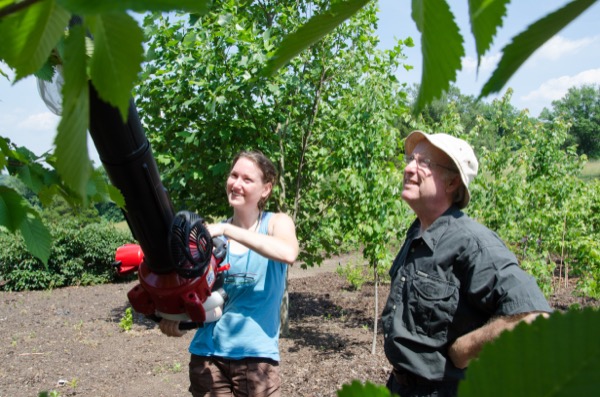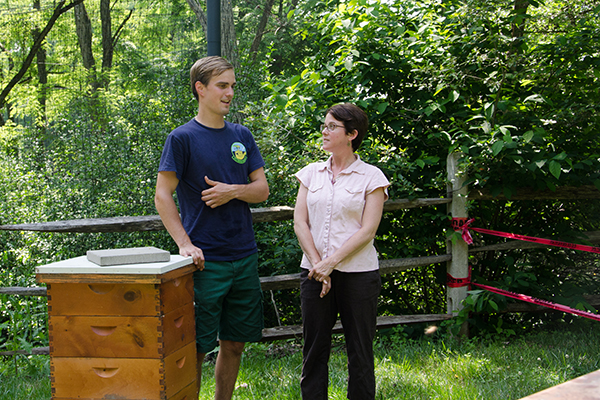


Looking good and doing good
UD partnership with Mt. Cuba aims to make 'eco-friendly' a selling point for modern gardeners
10:54 a.m., Jan. 15, 2016--Some plants are known for just plain looking good. These are the beauty queens of the horticultural world, the dahlias and orchids and lilies, turning their pretty faces toward the sun as if they’re aching to be adored.
Other plants are more highly regarded for their ability to do good—to sustain the species that rely on them and to improve the environment they inhabit. Not always as showy, and sometimes even a little awkward and drab, they tend to be ignored despite their inner charm by home gardeners intent on creating an enviable landscape.
Campus Stories
From graduates, faculty
Doctoral hooding
The elusive horticultural holy grail in this equation has been the plant that looks good and does good – after all, a plant with noble qualities does little good if no one wants to plant it.
So for the past year and a half, the Mt. Cuba Center and its partners at the University of Delaware’s College of Agriculture and Natural Resources (CANR) have been busy searching for varieties of native plants that will charm the customer, but also benefit the environment.
As part of the search, they are taking cues from the true judges of a plant’s beneficial nature — the bees, butterflies and other insects that gather (or not) on the flowers and leaves of the plants that gardeners cultivate.
Through funding from Mt. Cuba, the researchers have set up beehives at Mt. Cuba and on CANR’s campus in Newark and have been collecting and testing pollen that insects have collected as a way of determining which plants are favored, and which pollens and nectars have the greatest nutritional value to the insects.
Ultimately, they hope to compile a “digital pollen library” of flowering plants (and their genetically modified “cultivars”) in the Mid-Atlantic.
They’re also keeping a close eye on the insects for clues about the potential impacts that genetic modifications may have had on certain cultivars’ ability to be eco-beneficial — whether, for example, a genetic modification that causes a purple leaf might actually make a plant less palatable to a hungry bug.
In the end, they hope to get information into the hands of gardeners to help them select the beneficial-and-beautiful. But they also aspire to nurture the growth of a philosophical change among gardeners, convincing more of them that bugs (and buggy gardens) are indeed a good thing — not just for the sake of crops, but also for the survival of all plants and other members of the ecosystem.
It’s an effort that’s remarkable in its willingness to explore that “nebulous area where horticulture and ecology intersect,” says Jeff Downing, executive director at Mt. Cuba, a plant research center near Hockessin, Delaware, that is already well-regarded for its studies of native plants and their role in a healthy local ecosystem.
It’s also an effort that seems likely to boost and enhance Mt. Cuba’s growing reputation as a champion of native plants, taking it further than ever into the increasingly lucrative market for bio-beneficial plants.
The UD partnership, in which Mt. Cuba and UD researchers hope to make “eco-friendly” a selling point of certain cultivars, is rare in the world of horticultural product development.
It also aligns nicely with the shifting preferences of today’s gardeners. For decades, home gardeners lined up to buy plants that were marketed mainly for their color and beauty, says Eileen Boyle, Mt. Cuba’s director of education and research. But they seem increasingly likely today to also be attracted to a plant that is marketed as having the “best nectar for butterflies,” or the “best pollen for bees,” she has found.
“In the past, gardeners and landscape experts tended to treat plants like decorations, and ignored their ecological roles,” says Doug Tallamy, the professor in UD’s Department of Entomology and Wildlife Ecology who is helping lead the current studies, along with assistant professor Deborah Delaney. “Their priority was beauty for beauty’s sake, and insects weren’t too welcome in the garden.”
When the insects have plenty of “nature” around them to choose from, the bug-shunning inclinations of some gardeners aren’t such a problem, Tallamy says.
The trouble is, today’s overdeveloped East Coast landscape has diminished insects’ feeding grounds to such an extent that “the geographic separation of humans and nature is no longer ecologically viable,” in Tallamy’s view.
Even before the UD partnership began, Mt. Cuba had been working to help consumers choose varieties of popular plants that were best suited to the region.
Earlier in 2015, the center’s resident research horticulturalist published a guide summarizing the center’s research on a popular — but occasionally temperamental — plant called coreopsis.
That was preceded in the past few years by Mid-Atlantic guides to asters, coneflowers and heuchera, all summarizing which native cultivars “worked best.”
With the UD researchers now on board, that mission seems likely to gain greater momentum in the months ahead as research results become practical advice, working its way through the online networks of devoted home gardeners.
Originally, the UD researchers hoped to wrap up their studies at the end of summer 2015, but lower-than-expected caterpillar activity over the summer prompted them to extend their experiments through September.
In the meantime, Mt. Cuba will be continuing its efforts to draw the public even more deeply into its mission, through its twice-weekly guided garden tours, ongoing horticultural classes, and even an Ecological Gardening Certificate.
“We want people to realize that you don’t have to have an ugly garden to enjoy nature,” Boyle says. “Native plants are beautiful.”
Article by Eric Ruth
Photos by Danielle Quigley











